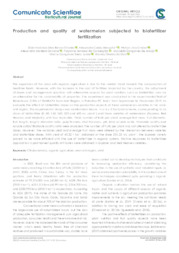Production and quality of watermelon subjected to biofertilizer fertilization.
Production and quality of watermelon subjected to biofertilizer fertilization.
Author(s): OLIVEIRA, Z. V. S. R.; MESQUITA, A. C.; SIMOES, W. L.; SALVIANO, A. M.; CONCEIÇÃO, P. B. da; ARAÚJO, M. G. de; TORRES JUNIOR, V. G.; SILVA, W. O. da
Summary: The expansion of the area with organic agriculture is due to the market trend towards the consumption of healthier foods. However, with the increase in the cost of fertilizers imported by the country, the adjustment of doses and management practices with alternative sources for plant nutrition, such as biofertilizer, can be an alternative for the sustainability of properties. The experiment was conducted in the experimental field of Bebedouro (CEB) of EMBRAPA Semi-Arid Region in Petrolina-PE, Brazil, from September to December 2019, to evaluate the effect of biofertilizer doses on the production aspects of three watermelon varieties in the semi-arid region. The experimental design was randomized blocks, in a 6 x 3 factorial scheme, corresponding to six doses of biofertilizer (0; 80; 160; 240; 320 and 400 mL plant-1) and three varieties of watermelon (Explorer, Red Heaven, and Majestic), with four replicates. Yield, number of fruits per plant, average fruit mass, fruit diameter, fruit length, length: diameter ratio, pulp firmness, rind thickness, pH, total soluble solids, titratable acidity and soluble solids/titratable acidity ratio were analyzed. The number of fruits per plant was not altered by biofertilizer doses. However, the variables yield and average fruit mass were altered by the interaction between varieties and biofertilizer doses. With yield of 40.22 t ha-1 obtained at the dose 201.33 mL plant-1, the Explorer variety proved to be more efficient with the use of biofertilizer in organic system. Positive responses to biofertilizer application in postharvest quality attributes were obtained in Explorer and Red Heaven varieti
Publication year: 2024
Types of publication: Journal article
Unit: Embrapa Semi-arid Region
Observation
Some of Embrapa's publications are published as ePub files. To read them, use or download one of the following free software options to your computer or mobile device. Android: Google Play Books; IOS: iBooks; Windows and Linux: Calibre.
Access other publications
Access the Agricultural Research Database (BDPA) to consult Embrapa's full library collection and records.
Visit Embrapa Bookstore to purchase books and other publications sold by Embrapa.

